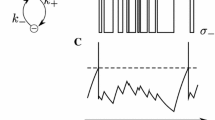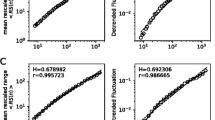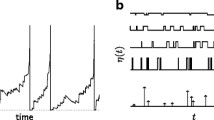Abstract
In the perfect integrate-and-fire model (PIF), the membrane voltage is proportional to the integral of the input current since the time of the previous spike. It has been shown that the firing rate within a noise free ensemble of PIF neurons responds instantaneously to dynamic changes in the input current, whereas in the presence of white noise, model neurons preferentially pass low frequency modulations of the mean current. Here, we prove that when the input variance is perturbed while holding the mean current constant, the PIF responds preferentially to high frequency modulations. Moreover, the linear filters for mean and variance modulations are complementary, adding exactly to one. Since changes in the rate of Poisson distributed inputs lead to proportional changes in the mean and variance, these results imply that an ensemble of PIF neurons transmits a perfect replica of the time-varying input rate for Poisson distributed input. A more general argument shows that this property holds for any signal leading to proportional changes in the mean and variance of the input current.
Similar content being viewed by others
References
Abbott LF, Chance FS (2005) Drivers and modulators from push–pull and balanced synaptic input. Prog Brain Res 149: 147–155
Abbott LF,van Vreeswijk C (1993) Asynchronous states in networks of pulse-coupled oscillators. Phys Rev E 48(2): 1483–1490
Abeles M (1991) Corticonics: neural circuits of the cerebral cortex. Cambridge University Press, Cambridge
Brunel N, Hakim V (1999) Fast global oscillations in networks of integrate-and-fire neurons with low firing rates. Neural Comput 11(7): 1621–1671
Brunel N, Chance FS, Fourcaud N, Abbott LF (2001) Effects of synaptic noise and filtering on the frequency response of spiking neurons. Phys Rev Lett 86(10): 2186–2189
Calvin WH, Stevens CF (1967) Synaptic noise as a source of variability in the interval between action potentials. Science 155(764): 842–844
Carandini M, Mechler F, Leonard CS, Movshon JA (1996) Spike train encoding by regular-spiking cells of the visual cortex. J Neurophysiol 76(5): 3425–3441
Dodge JFA, Knight BW, Toyoda J (1968) Voltage noise in limulus visual cells. Science 160(823): 88–90
Fourcaud N, Brunel N (2002) Dynamics of the firing probability of noisy integrate-and-fire neurons. Neural Comput 14(9): 2057–2110
Fourcaud-Trocmé N, Brunel N (2005) Dynamics of the instantaneous firing rate in response to changes in input statistics. J Comput Neurosci 18(3): 311–321
Frolov A, Medvedev A (1986) Substantiation of the ‘point approximation’ for describing the total electrical activity of the brain with the use of a simulation model. Biophysics 31: 332–337
Fuortes MG (1959) Initiation of impulses in visual cells of limulus. J Physiol 148: 14–28
Gerstein GL, Mandelbrot B (1964) Random walk models for the spike activity of a single neuron. Biophys J 4: 41–68
Granit R (1947) Sensory mechanisms of the retina. Oxford University Press, New York
Katz B (1950) Depolarization of sensory terminals and the initiation of impulses in the muscle spindle. J Physiol 111(3–4): 261–282
Knight BW (1972) Dynamics of encoding in a population of neurons. J Gen Physiol 59(6): 734–766
Knight BW, Toyoda JI, Dodge JFA (1970)) A quantitative description of the dynamics of excitation and inhibition in the eye of limulus. J Gen Physiol 56(4): 421–437
Koch C (1999) Biophysics of computation: information processing in single neurons. Oxford University Press, New York
Lindner B (2004) Interspike interval statistics of neurons driven by colored noise. Phys Rev E Stat Nonlin Soft Matter Phys 69(2 Pt 1): 022,901
Lindner B, Schimansky-Geier L (2001) Transmission of noise coded versus additive signals through a neuronal ensemble. Phys Rev Lett 86(14): 2934–2937
Miller KD, Troyer TW (2002) Neural noise can explain expansive, power-law nonlinearities in neural response functions. J Neurophysiol 87(2): 653–659
Naundorf B, Geisel T, Wolf F (2005) Action potential onset dynamics and the response speed of neuronal populations. J Comput Neurosci 18(3): 297–309
Nykamp DQ, Tranchina D (2000) A population density approach that facilitates large-scale modeling of neural networks: analysis and an application to orientation tuning. J Comput Neurosci 8(1): 19–50
Plesser HE, Geisel T (1999) Markov analysis of stochastic resonance in a periodically driven integrate-and-fire neuron. Phys Rev E 59(6): 7008–7017
Ricciardi L (1977) Lecture notes in biomathematics. Springer, Heidelberg
Salinas E, Sejnowski TJ (2002) Integrate-and-fire neurons driven by correlated stochastic input. Neural Comput 14(9): 2111–2155
Silberberg G, Bethge M, Markram H, Pawelzik K, Tsodyks M (2004) Dynamics of population rate codes in ensembles of neocortical neurons. J Neurophysiol 91(2): 704–709
Stein RB, French AS, Holden AV (1972) The frequency response, coherence, and information capacity of two neuronal models. Biophys J 12(3): 295–322
Troyer TW (2006) Factors affecting phase synchronization in integrate-and-fire oscillators. J Comput Neurosci 20(2): 191–200
Troyer TW, Miller KD (1997) Physiological gain leads to high isi variability in a simple model of a cortical regular spiking cell. Neural Comput 9(5): 971–983
Tuckwell HC (1988) Introduction to theoretical neurobiology, vol 2. Cambridge University Press, Cambridge
Wilson HR, Cowan JD (1973) A mathematical theory of the functional dynamics of cortical and thalamic nervous tissue. Kybernetik 13(2): 55–80
Author information
Authors and Affiliations
Corresponding author
Rights and permissions
About this article
Cite this article
Pressley, J., Troyer, T.W. Complementary responses to mean and variance modulations in the perfect integrate-and-fire model. Biol Cybern 101, 63–70 (2009). https://doi.org/10.1007/s00422-009-0317-6
Received:
Accepted:
Published:
Issue Date:
DOI: https://doi.org/10.1007/s00422-009-0317-6




